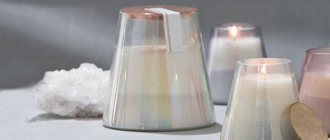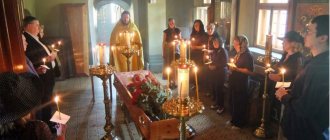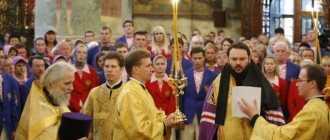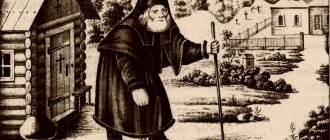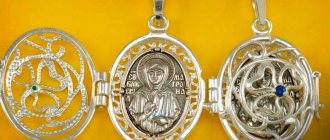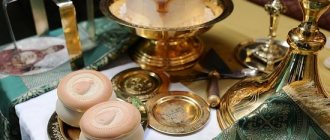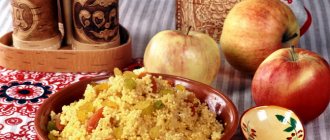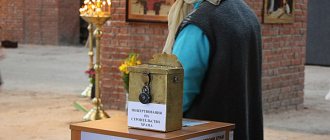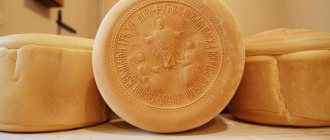Hello dear readers. Many people go to church every Sunday to light candles and pray for their loved ones. But not everyone visits the temple of God so often, so many things remain a mystery to them. If you were in church on Easter, you probably tried such a church treat as prosphora. Of course, not everyone has heard of this name, calling it simply “church bread.” But if you do attend church, then you need to know how and when to eat prosphora. Such information will not be superfluous for anyone. But first of all, you need to understand what prosphora is and why it is so important for the church. As you know, it is prepared with wheat flour and holy water, which is what makes these breads so special.
It is with their help that a person can not only cleanse himself of sins, but also draw closer to God.
In order to avoid getting into an uncomfortable situation while in church, you need to become more familiar with such a church treat as prosphora - what it is, what it is for, and when to eat it.
Having received the answer to these questions, you will understand how important this process is for believers, because there are many rules that must be followed in the process of consuming prosphora.
What is prosphora?
The meaning of the word “prosphora” translated from Greek means “offering.” In the first centuries of our era, people brought this bread to church, which is actually why it got its name.
This bread is prepared from the simplest ingredients that we usually use to make regular bread. That is, wheat flour, yeast, salt and water are used. But the main difference is that prosphora is prepared on the basis of holy water, which gives this bread special properties.
The use of plain flour and holy water is a symbol of the union of humanity and divinity in Jesus. Prosphora is used not only during major church holidays, but also during weekly visits to church.
The bread itself consists of two parts, which are first molded separately, but then joined together. That is why it turns out such an unusual shape. As you may have noticed, a special seal is placed on the top.
The lower part of the prosphora symbolizes the flesh of a person, and the upper part speaks of his spiritual beginning.
That is, such a division of bread into two parts means the division of a person into soul and body, which are components of one whole - a person. Bread combines flour and water, which also makes one bread.
Appearance and types of prosphoras
Few people know that the prosphora also symbolizes the bread that Jesus shared with his disciples at the Last Supper. That is why so much attention is paid to the consumption of this bread.
Outwardly, such a flour product bears little resemblance to bread, since it has a round shape, which makes it look like a cookie. The top of the product is decorated with a specific pattern, which was obtained thanks to a special printing.
In the image we can see an equilateral cross, which is surrounded on all sides by church symbols in the form of beeches.
In fact, prosphora differs from ordinary bread in that holy water is used in the process of its preparation. And on its top we can see a stamp with a certain design and inscription, which also make this treat special.
It is believed that such a product cannot spoil or become moldy, because it is sacred. But, of course, it also happens that even such bread becomes moldy or stale. Perhaps it's all due to an incorrect cooking process.
Kinds
Surely, you thought that there was only one prosphora that was used for any occasion. But this is not entirely true, because in total there are five varieties of prosphora, each of which has its own differences not only in purpose, but also in its appearance.
Mother of God
This bread is baked in the shape of a triangle, so it is quite easy to distinguish it from other types. At the top we can see the inscription “Holy Mother of God”. The product is laid out on a special dish with which it is served. Usually this type of prosphora is used specifically for church holidays.
Agnichnaya
This product is made in the shape of a cube. It is believed that during the chants such bread becomes the body of Jesus Christ. On the bread itself there is also a cross depicted, but in addition to this, a lamb is also carved. That is, initially the bread is baked in the same round shape, but only a cube is cut out of the finished product. The rest of the bread is simply distributed to the parishioners.
Nine-day
Nine equal parts are taken from the middle of the loaf of bread, which are dedicated to all the saints. That is, such bread is consumed for the prophets, apostles and saints.
Zazdravnaya
Such bread is divided into two equal parts, and after the service it is divided among all those present.
Funeral
In this case, only a small part of the top of the bread is used. It is used for all the dead, but this can only be done within the walls of the church. But eating bread, and even worse, crumbling it on the grave of the deceased, is strictly prohibited.
Artos and Antidor
As you already understand, all types of prosphora are baked from the same products and have a common round shape. The only difference may be in the image placed on the top of the product. So, the finished prosphora is divided into several parts, which can be of different shapes. It depends on the purpose of a particular prosphora.
Artos, translated from Greek, means “leavened bread.” This is the name given to the whole loaf of bread, which has a cylindrical shape.
The prosphora is placed in front of the altar long before Easter, but it is consecrated only on the Resurrection of Jesus Christ, that is, on Easter. After this, the already consecrated bread is distributed to the believers.
But note that the bread is not eaten on the same day. People take the blessed bread to their home, where it is stored for a certain time. Prosphora is consumed only when a person becomes ill and needs the help of the Lord.
In fact, this bread helps to cope with the illness that has struck a person. That is, ideally, such a flour product can be stored for an unlimited amount of time.
But Antidoron is translated from Greek as “time of communion.” This is the name given to the unused part of the bread, which remains after the inner part of the product is removed. Depending on the purpose of the bread, the shape of the extracted part will change. It can be either triangular or cubic.
This part of the product is distributed to people after the completion of the liturgy. It is believed that this part symbolizes the memory of the suffering of Christ. Please note that only baptized people can eat this part of the bread.
How to store and use prosphora
Such bread is sacred, which means it can only be eaten on special occasions. Prosphora should not be consumed every day, because in this way its direct purpose will be lost.
Usually such bread should be kept at the altar, but if it was distributed to parishioners, then at home it will only be kept near the icons. Otherwise, the bread will begin to deteriorate, which will mean a loss of its properties.
Eating bread also implies following certain rules. Therefore, you should eat the product slowly, chewing each piece. If there are crumbs left after eating bread, then they should also be eaten.
It is strictly forbidden to throw away such sacred bread, which means you will have to eat the crumbs. But besides this, there are other rules that must be followed.
1. This sacred product must be consumed in complete silence. At the same time, the process must be done slowly. It is strictly forbidden to use foul language at this time, even if the bread is just lying on the table.
2. You should not leave half-eaten bread on the table. The remaining parts must be carefully placed in a special bag, which is placed near the holy icons.
3. Prosphora can only be consumed by those people who have accepted the Orthodox faith. In addition, eating bread is prohibited during church services.
4. If you brought prosphora home, you can’t eat it right away either. Before you begin this process, you need to read a prayer. Please note that this bread is consumed only on an empty stomach.
As a rule, such a meal helps a person take the right path. In fact, he has the opportunity to start life anew, since his thinking is cleared, which means he is ready to do good deeds. A person feels a lightness that he has not experienced before.
Prosphora - what is it. What to do with it, why, when to eat it
The dough for such bread is kneaded with holy water, which means that all the bread becomes sacred. Thus, a person, consuming such bread, himself is sanctified.
Prosphora should be stored in a separate form, but if this is not possible at home, then there are special bags for storing such bread. It doesn’t matter where the bread will be stored, in a church or at home, the main thing is to place it next to the icons.
As we have already found out, such bread should be consumed only on an empty stomach. It should be noted that women during menstruation are prohibited not only from appearing in church, but also from eating sacred bread.
It is believed that any shedding of blood in the temple is unacceptable. Even if a person has any bleeding wound, he is also prohibited from going to church.
Holy bread should also not be consumed on Good Friday.
In addition to all of the above, there are other rules for using such a product:
✔ Do not mix prosphora with other products. The point is that you cannot eat other dishes, even lean ones, at the same time as this bread. Bread should be consumed separately, and only on an empty stomach.
✔ Before use, you must read a prayer. Only after this can you begin to eat the sacred bread.
✔ After you have brought bread from church, you need to lay a clean tablecloth on the table, on which you need to put the prosphora. During consumption, you can burn the bread with water, but this water must be consecrated;
✔ You should eat bread carefully so that not a single crumb falls on the floor.
If the bread is consumed after the service, and is usually washed down with warmth - warm water diluted with a small amount of wine. You can replace wine with jam, which will make the drink sweeter.
After the service, people are given a slice of prosphora, which must be washed down with warmth. It is important here that the sacred food is not in any way regurgitated as a result of unexpected coughing or spitting.
That is, if you came to church by car, then it is better for you to refrain from drinking wine. In this case, you can simply ask the church ministers for simple blessed water. But, under no circumstances should you spit out the wine you were supposed to drink.
What types of prosphoras are there?
There are large prosphoras (service ones) - they are used together with wine to prepare the substance of Communion, and small ones - from them the priest takes out small pieces, while remembering people for health and repose (that is, praying for the living and the dead). At the end of the Liturgy, the priest, with the words “washed away, Lord, the sins of those who are remembered here with Your honest Blood,” pours all these particles into the Chalice with the Blood of Christ. Small prosphoras are distributed to believers after the service. Read more about prosphora, their types and use in the liturgy in our material.
If the prosphora has spoiled, what should you do with it?
As a rule, prosphora cannot become moldy, since it is prepared in holy water. But sometimes it happens that bread can simply go stale. No amount of holy water can prevent this process.
Of course, you can’t eat bread in this form, and you’re unlikely to succeed. But please note that throwing away church bread is strictly prohibited.
Therefore, if it has already happened that the bread has somehow spoiled, then it is necessary to dispose of it as follows:
✔ Burn the remaining missing bread.
✔ Bury the remaining bread in damp soil.
✔ Place in running water.
Under no circumstances should leftover bread be thrown into the trash, remember this. In addition to the options listed, you can also take bread to church. Give the bread to the church servants, because only they know what to do with the bread that has already become unusable.
Probably the last option is the simplest, since you will not have to perform strange rituals of burning or burying church bread. Leaving spoiled bread in your home is also not recommended.
Not everyone goes to church every week, and some do not always attend on holidays. Therefore, not everyone knows what prosphora is and how it is used correctly.
But regardless of whether you go to church regularly, or visit it only on holidays, you should know how and when prosphora is used. In addition, if you have the opportunity to eat a slice of this sacred bread, then you must know the rules for its use.
In addition, you must understand that throwing away the sacred bread is strictly prohibited, even if it has somehow spoiled. If you, out of ignorance, got rid of bread by simply throwing it in the trash, then such an action is equivalent to sin.
Prosphora - what is it and what is it for?
Prosphora is a small bread that has a round shape. It is prepared from wheat dough, which is kneaded in holy water. Several facts are known about this treat:
- the word “prosphora” is translated from Greek as “offering”;
- Apart from yeast and salt, no additives are added to such baked goods;
- in the Orthodox Church it is believed that such baked goods consist of two parts, which symbolize the fusion of human and divine essence united in Jesus Christ;
- On top of the bread there is a seal in the shape of a cross, which have equal sides. In the corners there are the letters IC XC NI K. A. Such an inscription means “Jesus Christ conquers,” and the seal is the personification of the invisible seal of the image of the Lord;
- depicts the prosphora bread of the Last Supper, which Jesus shared among the disciples.
Appearance and taste
Not all believers know for certain that the prosphora symbolizes the bread of the Last Supper, which Jesus Christ once divided among his disciples. Externally, this is a small round cookie, on the top side of which you can see a cross with equal sides and letters in the corners: IS XC NI KA. This inscription also has its own meaning and interpretation, and is translated as “Jesus Christ conquers.” Prosphora is a seal of the image of the Lord, which extremely rarely can become moldy, dry out, or become unusable.
Forms of church bread
Church mallow comes in several forms. There are five types of them based on the seals for the prosphora:
- Agnic. This product is large in size with a cross. A lamb is cut out of it with a special knife - bread, which has the shape of a cube. During the liturgy, the lamb becomes the true body of Christ. The part that was not used is called antidor. After the service it is distributed to believers.
- Mother of God. On such a loaf there is a stamp “Mary” or the image of the Mother of God. When proskomedia passes, a triangle-shaped part is removed from the upper part. It is placed on a special dish next to the lamb.
- Nine-day. Such a mallow is dedicated to all the saints, and during the service nine parts are taken out of it.
- Zazdravnaya. Two parts are taken out of such baked goods for everyone who participates in the liturgy.
- Funeral. From this they take only one part from above for all the deceased believers.
In addition to these species, there are several more special species. This is artos - a loaf of bread that is blessed on Easter night. At this time, the clergyman asks God for blessings and help in healing ailments. This type of prosphora is located opposite the Royal Doors throughout Bright Week. On Saturday, it is divided into small parts and distributed to believing parishioners. Artos is a symbol of the resurrection of Jesus Christ and should remind of his presence on earth.
Eating Church Bread
There are several rules about prosphora. All believers need to know how to use it. First of all, this is done on an empty stomach in the morning. It is recommended to first spread a clean napkin on the table and place bread and some water on it. When eating bread at home, before eating it, you should read a prayer specially designed for such cases. It is necessary to eat the bread over a plate and make sure that the crumbs do not fall on the floor. They do not use mallow in cemeteries either. You also can't paint it there.
To cut the sacred bread, temples use a knife specially designed for this purpose. It's called a copy. It is a knife that has a spear-shaped tip. This knife should not be stored next to other cutlery. The clergy do not recommend cutting prosphora with ordinary kitchen cutlery.
It is generally accepted that reading a prayer before eating sacred bread and drinking holy water leads to the sanctification of the body and spirit and helps protect against evil spirits. The prosphora, divided into parts, is taken out at the end of the service, at which time parishioners should fold their palms into a cross. In this case, the right palm should cover the left. After handing over the bread, you should kiss the priest's hand. After it is brought home, it should be placed on a clean napkin. Before drinking holy water with mallow, you need to read a prayer.
If the prosphora has become moldy or spoiled
Sometimes sacred bread brought home can dry out or become moldy. Believers need to know what to do with it and how to act correctly. You can deal with dried bread very simply - you should soak it, using holy water, and eat it. This church treat is kept in the corner where the icons stand. For long-term storage, it is better to put it in a paper bag.
If the prosphora becomes moldy, what should you do? This is primarily considered the result of careless handling of the shrine. Therefore, the clergy consider this a sin and recommend confession. The moldy loaf is dealt with in the same way as other sacred objects that must be destroyed. You can do this as follows:
- bury in a place where people do not walk;
- float down the river. In this case, it is necessary to ensure that it does not stick to the shore (you can crush it or tie it to a stone);
- if the loaf has spoiled, you can take it to church, where it will be burned;
- The clergy are allowed to crush the bread and give it to the birds, but throwing the crumbs on the ground is prohibited; it is recommended to put them on a board. Giving prosphora to animals is prohibited.
An important church treat is prosphora, the use of which in the church is treated with particular scrupulousness. These are unleavened bread made with holy water and wheat flour, which become a source of holiness for parishioners.
Many people, attending church services, noticed that small breads called prosphora were handed out. They are considered a real shrine that must be honored and protected so that it does not deteriorate. There are known rules regarding the use of such church treats.
Prosphora is:
A small round loaf of bread made from leavened wheat dough with holy water is called prosphora. There are several facts about this church treat:
This word is translated from Greek as “offerings.”
No additives are added to such baked goods, with the exception of yeast and salt.
This pastry consists of two parts, which symbolizes the union of human and divine essence in Jesus Christ.
On the upper part there is a seal in the form of a cross with equal sides and in the corners there are the letters: IC XC NI KA. The inscription presented means “Jesus Christ conquers.” The seal itself personifies the invisible seal of the image of the Lord.
If you are interested in what the prosphora symbolizes, then it is worth knowing that it depicts the bread of the Last Supper, which Jesus divided among his disciples.
There are five main types of sacred bread for the liturgy:
Agnichnaya
This is a large prosphora with a cross, from which a lamb is cut out with a special knife - cube-shaped bread. During the liturgy, he becomes the true body of Christ. The part of the prosphora that is not used is called antidor, and it is distributed to believers after the service.
Mother of God
This large prosphora bears the seal “Mary” or the image of the Mother of God. During proskomedia, a triangular-shaped part is taken out from the top and placed on a special dish along with the lamb.
Nine-day
This view is dedicated to all the saints and nine particles are taken from her seal.
Zazdravnaya
Two parts are taken from this bread for all participants in the liturgy.
Funeral
For all the deceased believers, only one particle is taken from the upper part of the prosphora.
There are special types of prosphora, which include artos - bread blessed on Easter night. The priest asks the Lord for blessings and help in healing illnesses. Artos is located opposite the Royal Doors throughout Bright Week, and on Saturday it is divided into small pieces and distributed to believers. This prosphora symbolizes the resurrection of Jesus Christ and recalls his presence on earth.
Artos and Antidorus in Orthodoxy
When studying the varieties of prosphora, it is worth highlighting such a church concept as “artos”. This is the Greek word “arto”, which literally translates as “leavened bread”. So what is artos and why is this concept important in the Orthodox religion? Such a prosphora is placed in front of the altar on Easter Bright Week, consecrated on Easter, and divided and distributed to believers on Saturday of Bright Week. Such bread is supposed to be kept at home, and eaten if a believer is suddenly overtaken by illness, he falls ill.
Antidoron (translated as “instead of communion”) is the unused part of the bread, which after the completion of the liturgy is distributed to all parishioners who wish. From the point of view of Christianity, this is the memory of the suffering of Christ on the cross. Therefore, it is necessary to use antidor carefully and carefully.
It is important to clarify that such a portion of the sacred bread should not be given to unbaptized people. If artos is a symbol of the resurrection of Christ and a reminder of his stay on earth, but antidor is the eternal memory of his suffering for human sins.
How to eat prosphora at home and store it
This liturgical liturgical bread is supposed to be eaten only on occasion, so prosphora should not become part of the parishioners’ usual diet. The loaf should be kept at the altar in the church or at home near the holy icons. It is necessary to consume prosphora internally slowly, chewing each crumb thoroughly. If there are crumbs left after a meal, you definitely need to pick them up and eat them too. Other rules for using and storing this sacred bread are presented below:
1. It is important not to swear or use foul language if there is bread or prosphora on the table. Complete silence and spiritual subjugation are required.
2. The bread should not remain on the table; after eating, it must be carefully placed in a special bag.
3. Eating the sacred bread inside is permitted only after accepting the Orthodox faith and completing events serving God.
4. Prosphora can be brought home and consumed only after fervent prayer with pure thoughts and always on an empty stomach.
5. Such a meal is conducive to good deeds, helps to feel spiritual holiness and lightness, and allows a person to start a new life in the right way of thinking.
When to eat prosphora
Prosphoras, like sacred bread, sanctify the one who eats them. Such bread should be stored in special molds; it is advisable not to remove them from the icons, but to be consumed internally mainly on an empty stomach. If a woman is having her period, it is important to remember that during her menstrual period it is better for her not to appear in church at all and, especially, not to eat this sacred bread. The same restriction applies to Good Friday, when it is also undesirable to sanctify one’s own body. Below are other rules for the correct use of this church ingredient:
1. It is important not to mix the consumption of sacred mallow with other dishes during the main meal.
2. Before putting a piece in your mouth and slowly eating it, you should pray fervently.
3. Before eating such bread, after the service in church, you need to lay a clean and snow-white tablecloth on the table, pour about three sips of holy water into a glass.
4. When consuming, it is important to be especially vigilant so that not a single crumb remains on the floor.
5. After chewing the prosphora, you must drink about three sips of holy water and not choke.
If the prosphora is dry or moldy
The malt cannot go bad - it cannot become moldy and sour. The only thing a prosphora can do in a church is dry out. It is not recommended to use it in this case, and it is unlikely to work. But throwing it into the trash bin is also strictly prohibited. To properly dispose of prosphora, you must:
burning lamb loaf; burying in damp soil; direction into running water.
Many exemplary parishioners prefer to take it to church and give it to the ministers for further disposal. This is a good option, because the temple knows what to do if the food unexpectedly dries out and becomes completely unusable. Nothing complicated, especially since leaving such a spoiled and unusable dish in the house is also not recommended.
Kinds
Before using such bread in church, it is important to know its purpose and all the existing varieties. According to church laws, the classification is as follows:
- Mother of God prosphora. This is a large triangular-shaped loaf of bread that has the inscription “Mary” or “Holy Mother of God”. It is placed on a special dish along with the lamb, and is consumed mainly on religious holidays.
- Agnic. This is a large cube-shaped bread, which during the liturgy becomes the true body of Jesus Christ. Externally, the prosphora is equipped with a cross, from which a lamb is cut out with a special knife. The unused part of the bread, called antidor, is distributed free of charge to parishioners after the service.
- Nine-day. From a seal of this type, 9 particles are taken out, which are dedicated to all the saints. It is required to use for John the Baptist, Joachim and Anna, the prophets, saints, apostles, Archdeacon Stephen and the martyrs, the unmercenaries, Methodius and Cyril, Prince Vladimir, all saints. Dedicated to the holy author of the liturgy, for example, John Chrysostom or Basil the Great.
- Zazdravnaya. The sacred bread is divided into two symmetrical parts and eaten for all participants in the liturgy after the service in the church.
- Funeral. For such a case, only one particle is taken from the upper part of the prosphora, which must be eaten for all the dead and deceased. This cannot be done in the cemetery after the funeral service and burial of the newly appointed servant of God; it is strictly forbidden to crumble the bread on the graves.
Artos and Antidorus in Orthodoxy
When studying the varieties of prosphora, it is worth highlighting such a church concept as “artos”. This is the Greek word “arto”, which literally translates as “leavened bread”. So what is artos and why is this concept important in the Orthodox religion? Such a prosphora is placed in front of the altar on Easter Bright Week, consecrated on Easter, and divided and distributed to believers on Saturday of Bright Week. Such bread is supposed to be kept at home, and eaten if a believer is suddenly overtaken by illness, he falls ill.
Antidoron (translated as “instead of communion”) is the unused part of the bread, which after the completion of the liturgy is distributed to all parishioners who wish. From the point of view of Christianity, this is the memory of the suffering of Christ on the cross. Therefore, it is necessary to use antidor carefully and carefully. It is important to clarify that such a portion of the sacred bread should not be given to unbaptized people. If artos is a symbol of the resurrection of Christ and a reminder of his stay on earth, but antidor is the eternal memory of his suffering for human sins.
- Treatment of opisthorchiasis with folk remedies at home - recipes for children and adults
- Barley - benefits and harms for weight loss, diet and dietary cereal dishes with recipes
- Manual dumpling maker: how to use the grid
